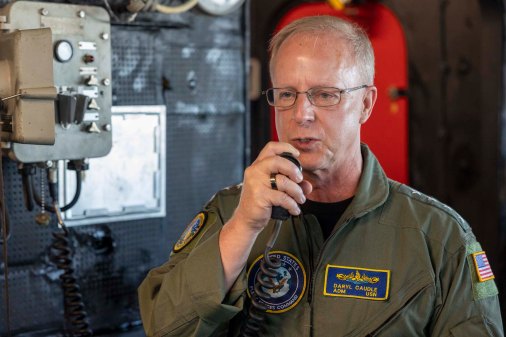New Navy CNO eyes unmanned systems, disruptive tech to augment force

In her first major speech since taking helm of the service, Chief of Naval Operations Adm. Lisa Franchetti said she sees unmanned systems and other emerging technologies as a key piece to her vision of the future.
“We will put more players on the field, which means ready players,” Franchetti said Tuesday during her keynote speech at the Surface Navy Association’s annual symposium. “Platforms that are ready with the right capabilities, weapons and sustainment, and people who are ready with the right skills, tools, training and mindset.”
Along with timely ship deliveries and improvements to maintenance practices, Franchetti said the Navy must take full advantage of unmanned systems and disruptive tech in order to ready the service for potential conflicts.
The goal isn’t to reach a specific number of manned or unmanned vessels, but rather ensuring all of the Navy’s assets are effectively contributing to an overall “warfighting ecosystem,” she told reporters after her keynote.
Like other components across the U.S. military, the Navy has made significant investments towards testing robotic platforms and incorporating them into operations. One of the most forward-leaning efforts for the sea service is Task Force 59, formed in 2021 under 5th fleet in the Middle East to help integrate unmanned systems and artificial intelligence tools that would strengthen maritime domain awareness and enhance deterrence.
Task Force 59 reached full operational capability in early 2023, and the Navy has been experimenting more with drones and supporting technologies in the Indo-Pacific and Central and South American seas, Franchetti said.
“Now, we really need to look at what is all of our unmanned technology that we’re experimenting with?” she told DefenseScoop. “What are the concepts that we’re going to use to employ all these unmanned [systems]? How are we going to train people to work with them? How are we going to knit them together so they can augment our conventional platforms and really expand our force and the ability that we have to do things?”
The CNO also highlighted work underway at the service’s new Disruptive Capabilities Office, launched by Navy Secretary Carlos Del Toro in September. The organization aims to rapidly deliver new advanced warfighting capabilities to sailors and Marines.
“I’m really excited about seeing what they come up with and how they really quickly scale good emerging technology and put that into the hands of warfighters in just a couple of years,” Franchetti said.
Her remarks at the symposium coincided with the release of a paper outlining her priorities as CNO — titled “America’s Warfighting Navy” — categorizing her focus areas into three lines of effort: warfighting, warfighters and foundations.
“We must move rapidly to stay ahead and continuously create warfighting advantages. We must think, act, and operate differently, leveraging wargaming and experimentation to integrate conventional capability with hybrid, unmanned, and disruptive technologies,” it states. “Tomorrow’s battlefield will be incredibly challenging and complex. To win decisively in that environment, our Sailors must be the best warfighters in the world with the best systems, weapons, and platforms to ensure we can defeat our adversaries.”






